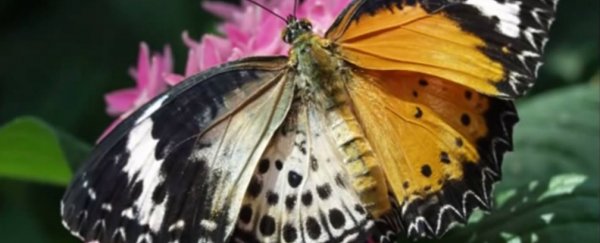The butterfly shown has a completely unique pattern of colours because of a special trait - it has two different sexes.
It looks like it was two butterflies cut down the middle and sewn together: One half of its wings are orange from male DNA, while the other half are pale yellow, created by cells with female DNA.
You can see in the image below that male leopard lacewing butterflies have orange wings with black and white bands at the tips (right), and females are a pale yellow with those same black and white bands (left):
 Wikimedia Commons/Greg Hume; Wikimedia Commons/D. Gordon E. Robertson
Wikimedia Commons/Greg Hume; Wikimedia Commons/D. Gordon E. Robertson
The scientific name for this phenomenon is gynandromorphism.
Animals that are gynandromorphs are made up of both male and female cells, when usually, an animal is made up of all female cells or all male cells. It's hard for researchers to estimate how frequent gynandromorphs are in the wild because they can be hard to identify, since they aren't all as clearly male-female as the butterfly above.
These characteristics don't just appear as half-and-half butterflies either, the male and female cells can also swirl together to form a 'mosaic' pattern that mixes the colours together, like in this swallowtail butterfly, in which you can see the yellow male cells and blue female cells.
 Notafly/Wikimedia Commons
Notafly/Wikimedia Commons
These characteristics and patterns are conferred by genes on the butterfly's sex chromosomes. Typically each butterfly cell has two sex chromosomes, Z and W, and each parent will pass one of their chromosomes on to their offspring. If their offspring gets Z chromosomes from both parents then it will be a male, if it gets a Z from the dad but a W from the mother then it will be a female. The number of Zs is what determines which sex a butterfly becomes. (The names of these sex chromosomes vary - in humans they are the X and Y chromosomes.
Some gondaomorphs are created when the two W and Z chromosomes get stuck together while a cell is splitting - resulting in some cells with too few chromosomes and others with too many. This makes some cells female and others male depending on the combination of chromosomes the cells have.
In other gynandromorphs, the egg erroneously has two nuclei, hanging on to both Z and W chromosomes, which is then fertilised by two sperm (which adds a Z to each nuclei), this rare event is called double fertilisation. Double fertilisation will result in some of the nuclei being female (ZW) and others male (ZZ) that then continue to divide and act as one embryo as development progresses.
Gynandromorphism isn't limited to butterflies. All kinds of butterflies and moths can be gynandromorphs, as can crabs or lobsters, other insects, and even some birds, like this confused cardinal:
 Peer Lab
Peer Lab
This article was originally published by Business Insider.
More from Business Insider:
